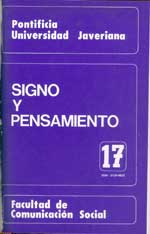Abstract
Imaginemos un acontecimiento hipotético: Yamit Amat aparece un día cualquiera a las seis de la mañana y anuncia frente a los micrófonos. “Estimados oyentes de la cadena básica de Caracol, nos permitimos informarles que hoy esta emisora por motivos que escapan a nuestro control, no transmitirá su habitual programación informativa porque no hay noticias. El equipo periodístico de Caracol retornará cuando haya algo interesante que comentar”. Aparte de la alegría que representaría para algunos, la información sería casi aterradora; seriamos presa de un espantoso sentimiento de aislamiento y angustia. Se ha roto nuestro contacto con el mundo Nuestra forma contemporánea de vivir en sociedad se vería amenazada. Decimos que este sería un acontecimiento hipotético, y en nuestra sociedad actual, imposible. Los medios de comunicación que transmiten noticias, si no las tienen, tendrán que inventarlas al menos para llenar los espacios publicitarios que hacen posible su programación, lo que si es muy probable es que se sacrifique información por falta de publicidad. Primera evidencia: la noticia es una mercancía que tiene carácter perecedero. Lo que hoy es noticia, mañana es historia. Dada esta presión de la publicidad, se ha ido redefiniendo lo que es y lo que no es noticia. Con el tiempo, se ha ampliado el número de sucesos susceptibles de ser convertidos en relatos noticiosos y esto ha traído a la par la ampliación de las organizaciones informativas y su especialización: se trata de lograr la mayor cantidad de noticias en el menor tiempo posible y con una inversión mínima.This journal is registered under a Creative Commons Attribution 4.0 International Public License. Thus, this work may be reproduced, distributed, and publicly shared in digital format, as long as the names of the authors and Pontificia Universidad Javeriana are acknowledged. Others are allowed to quote, adapt, transform, auto-archive, republish, and create based on this material, for any purpose (even commercial ones), provided the authorship is duly acknowledged, a link to the original work is provided, and it is specified if changes have been made. Pontificia Universidad Javeriana does not hold the rights of published works and the authors are solely responsible for the contents of their works; they keep the moral, intellectual, privacy, and publicity rights.
Approving the intervention of the work (review, copy-editing, translation, layout) and the following outreach, are granted through an use license and not through an assignment of rights. This means the journal and Pontificia Universidad Javeriana cannot be held responsible for any ethical malpractice by the authors. As a consequence of the protection granted by the use license, the journal is not required to publish recantations or modify information already published, unless the errata stems from the editorial management process. Publishing contents in this journal does not generate royalties for contributors.


